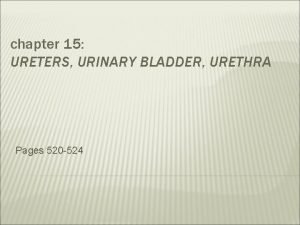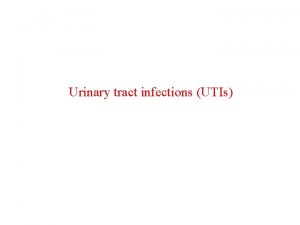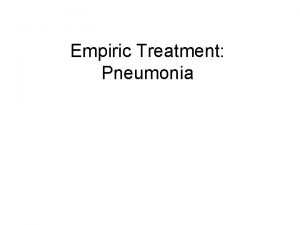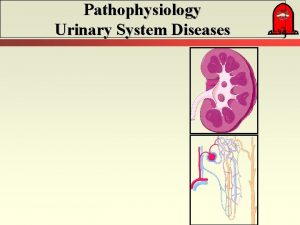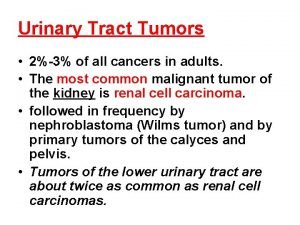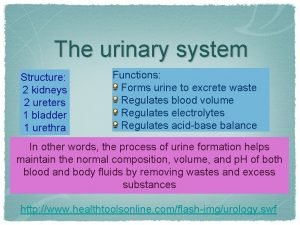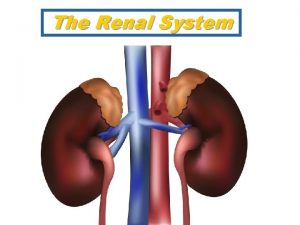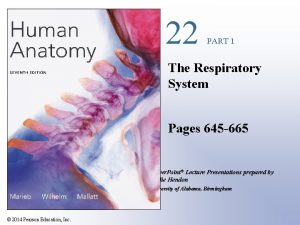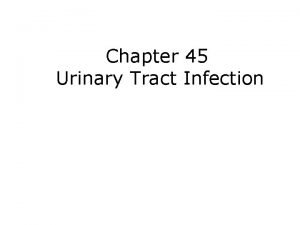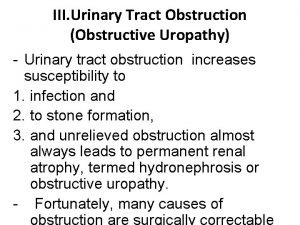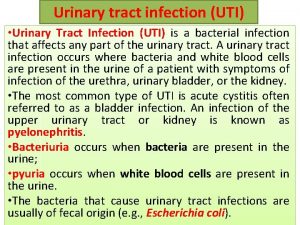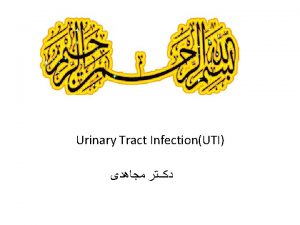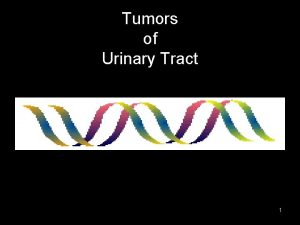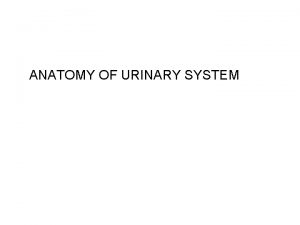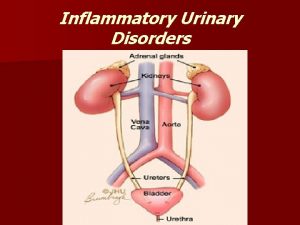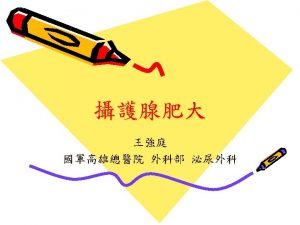Anatomy of the Urinary Tract Urinary Tract Anatomy





















- Slides: 21

Anatomy of the Urinary Tract

Urinary Tract Anatomy of Urinary Tract ◦ Need basic knowledge of kidney structure ◦ Urine formation knowledge ◦ Both necessary to understand results of a UA Urinary Tract ◦ ◦ Two kidneys Two ureters One bladder One urethra

Urinary Tract Kidneys – 2 ◦ Reddish Brown bean shaped organs ◦ Four to five inches long and located in the retroperitoneal space slightly above the waistline in the posterior wall of abdominal cavity. ◦ (Behind the peritoneal cavity) ◦ Kidney made up of three (3) main sections: ◦ Cortex: Outer part ◦ Medulla: Middle section ◦ Renal pelvis: hollow inner section. ◦ Basic functional unit = Nephron (microscopic) ◦ More than 1, 000 million nephrons

Urinary Tract Urinary System Part 1 - The Kidneys - You. Tube

Urinary Tract Nephron: ◦ Located within the cortex and medulla. ◦ Filter waste from the blood and simultaneously maintain the essential water and electrolyte balance of the body. ◦ Structural components of nephron are renal corpuscle and renal tubules. ◦ Renal Corpuscle consists of two structures: ◦ Glomerulus: ◦ Glomerular (Bowman’s capsule)

Urinary Tract Glomerulus: ◦ Made up of tangled blood capillaries in which the hydrostatic pressure in the capillaries pushes substances through the capillary pores. ◦ Filtered substance is the glomerular filtrate and is collected in the glomerular capsule. (Bowman’s capsule) – a cup shaped structure surrounding the glomerulus.

Urinary Tract Renal Tubules: ◦ ◦ Composed of proximal convoluted tubules The nephron loop (loop of Henle) Distal convoluted tubles Glomerular filtrate fluids flows through these tubules and undergoes changes in composition. Additionally: ◦ Within the medulla of the kidney are collecting tubules and ducts that empty into the renal pelvis.

Urinary Tract Ureters ◦ Two in number ◦ Slender muscular tubes 10 – 12 inches long ◦ Function: Carry urine formed in the kidneys to the urinary bladder. Bladder: ◦ Hollow muscular organ that hold the urine until it is expelled by a process call micturition ( also referred to as voiding and urination). Uretha: ◦ ◦ A tubular structure Function carries urine to the outside of the body. Size female 1. 5 inches; male 8 inches Opening at end of uretha where urine is excreted is called Uretha meatus.

Urinary Tract

Urinary Tract

Formation and Flow of Urine The Kidney selectively excretes or retains substances according the body’s needs and renal thresholds. Approximately 1, 200 m. L of blood flows through the kidneys each minute. Nephron: Basic unit of kidney where urine is formed Urine formed by three mechanisms ◦ Filtration ◦ Reabsorption ◦ Secretion

Formation and Flow of Urine Filtration: the process by which fluids and dissolved substances in the blood are forced through the pores of the glomerulus into the glomerular capsule by hydrostatic pressure. Filtration: ◦ Substances: water, salts, sugar and nitrogen waste products (urea, creatinine and uric acid) pass through the pores. ◦ Substances: RBCs, and proteins are too large therefore remain in the blood.

Formation and Flow of Urine Reabsorption: Process by which some of the substances that flow through the renal tubules that are needed by the body cross back into the blood by the peritubular capillaries surrounding the tubules. ◦ Examples: glucose, water, electrolytes. (Electrolytes: elements or compounds that form positively or negatively charged ions that when dissolved, can conduct electricity. ) ◦ When blood levels of a substance such as glucose reach a point at which no more can be reabsorbed, the substance is excreted in the urine…. Renal Thresholds: levels at which substances cannot be reabsorbed by the renal tubules and therefore excreted in the urine. ◦ FYI: Renal threshold for glucose = 160 -180 mg/d. L

Formation and Flow of Urine Secretion: Final process in the formation of urine. ◦ Substances are carried from the peritubular capillaries into the renal tubules. ◦ Examples: Metabolized drugs, potassium, and hydrogen ions are examples of substances that are secreted into the urine.

Formation and Flow of Urine Flow of Blood and Urine through the kidneys: ◦ ◦ ◦ Blood carried into the kidney by the renal artery Renal artery branches into the afferent arterioles. Afferent arterioles carry blood into the capillaries of the glomerulus. Efferent arterioles carry blood out of the glomerulus. Glomerular filtrate is collected in the glomerular capsule (Bowman’s) and flows through the proximal convoluted tubules to the nephron loop. ◦ Then to the distal convoluted loop, the collecting tubule, the collection duct, and finally to the calyces of the renal pelvis. ◦ The filtrate then flows into the hollow renal pelvis and at this point is called urine.

Flow of Urine The urine then passes through the ureters to the urinary bladder. Urine is stored in the bladder until released by a process known as urination, voiding or micturition. 10 Step process: ◦ ◦ ◦ Blood stream – renal afferent arterioles. Glomerulus Glomerular capsule (Bowman’s) Renal tubules Collecting ducts

Flow of Urine 10 Step process cont ◦ ◦ ◦ Renal pelvis Ureter Urinary bladder Urethra Urinary meatus – urine expelled.

Composition of Urine Water is 95% of urine Contains Nitrogen waste products such as urea, uric acid, ammonia and creatinine. Urea, uric acid and ammonia are derived from the breakdown of protein. Creatinine is a waste product of muscle metabolism. Other waste products include Chloride, sodium, potassium, calcium, magnesium, phosphate and sulfate. As mentioned 1, 200 m. L of blood passes into the renal arteries per minute with a daily output of 1200 – 1500 m. L of urine per day. ◦ Volume varies dependent on the amount of fluid intake and the amount of fluid lost from perspiration, feces, and water vapor from the lungs.

Terms related to urination Oliguria: decreased urine volume that can occur in the following situations: ◦ ◦ ◦ Decreased fluid intake Vomiting Profuse sweating Diarrhea Kidney disease.

Terms related to urination Diuresis: increase in the volume of urine output, which can be caused by the following ◦ Intake of excessive amounts of fluids, especially those that contain caffeine ◦ Some drugs such as diuretics ◦ Some types of diseases, such as diabetes mellitus, diabetes insipidus, and renal diseases that prevent the kidney from concentrating the urine. Anuria – no flow of urine Dysuria – painful urination Nocturia – excessive urination at night Polyuria – frequently passing abnormally large amounts of urine.

END
 Urinary bladder
Urinary bladder Complicated uti symptoms
Complicated uti symptoms Urinary tract infection in pregnancy ppt
Urinary tract infection in pregnancy ppt Complicated urinary tract infection
Complicated urinary tract infection Urised otc
Urised otc Histological structure of kidney
Histological structure of kidney Uti symptoms men
Uti symptoms men Tumor in the urinary tract
Tumor in the urinary tract Extrapyramidal tract function
Extrapyramidal tract function Dorsal reticulospinal tract
Dorsal reticulospinal tract Urinary system anatomy
Urinary system anatomy Kidney in human body
Kidney in human body Upper and lower airway diagram
Upper and lower airway diagram Female reproductive system external
Female reproductive system external Anatomy of the upper respiratory tract
Anatomy of the upper respiratory tract External nose
External nose đặc điểm cơ thể của người tối cổ
đặc điểm cơ thể của người tối cổ Các châu lục và đại dương trên thế giới
Các châu lục và đại dương trên thế giới Mật thư anh em như thể tay chân
Mật thư anh em như thể tay chân Tư thế worm breton là gì
Tư thế worm breton là gì ưu thế lai là gì
ưu thế lai là gì Thẻ vin
Thẻ vin
